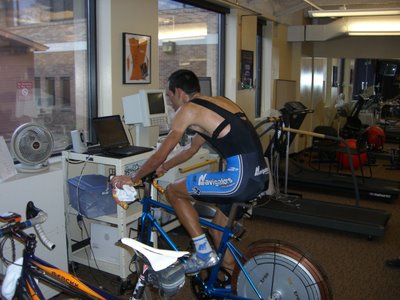
Testing at Boulder Center for Sports Medicine~
Cesar Grajales is training in Boulder for the upcoming Tour of Utah August 7-12th. The altitude and mountain rides around Boulder should really benefit him and be perfect training prior to such a hard stage race.
Last week Cesar included a day of testing at the Boulder Center for Sports Medicine. We first conducted a lactate threshold ramp test which increased 25 watts every four minutes. At the end of each stage blood was drawn from a finger and then analyzed for the amount of lactate in his blood. Cesar's LT wattage occurred at 350watts and a HR of 174.  This should help Cesar dial in his lactate threshold intervals on both the road and TT bikes.
This should help Cesar dial in his lactate threshold intervals on both the road and TT bikes.
This is my world of cycling and just a fun way for me to share my experiences, thoughts and joy I have for cycling. Thanks for visiting Cycle Jabber and good luck in your training! Dirk Friel

3 Comments:
There was no particulrreason for testing Cesar this tiem of the year. The opportunity just presentd itself and we both wanted to try and get him tested at some point this season. Ideally I'd ant him to get tested in December or January at the beginning of thr base period, then again in about March, and yet again near a peak period. By having all of these data points we could then have a better understanding of how certain types of training resulted in improved results. The degree of improvement could also be determined from one test to the next.
Dirk
7:17 AM
dirk, what protocol for LT was used? 4Mml? 1Mml above baseline?
thanks.
1:37 PM
KP- I asked the same question to Neal Henderson who heads up the sports science at BCSM. He wrote"The protocol that we use is adapated slightly for each rider, but primarily involves a 15-20 minute warm-up of very low intensity pedalling (typically, 40-50% of suspected power at lactate threshold). The initial lactate profile test involves 4-minute stages beginning at between 150 and 200 watts (depending on the weight and fitness of the rider), and increasing by 25-watts every 4 minutes. Blood lactate and blood glucose is measured using a YSI Stat Plus 2300, and heart rate is monitored via telemetered Polar heart rate monitor (810i). Perceived effort is evaluated using Borg's modified RPE scale (0-10). Once an increase in blood lactate of greater than 1.5 mmol/L has been identified, the rider then recovers for 5-10 minutes prior to the VO2 max protocol. During recovery they may take a bathroom break, stretch/etc. off the bike if they would like. The VO2 max test begins at one workload below lactate threshold, and increases 25-watts every minute until failure. BLood lactate is measured at the end of the VO2 max, and 2 minutes post-test. Metabolic measurements are taken with a calibrated and verified Sensormedics Vmax 229."
7:30 AM
Post a Comment
<< Home